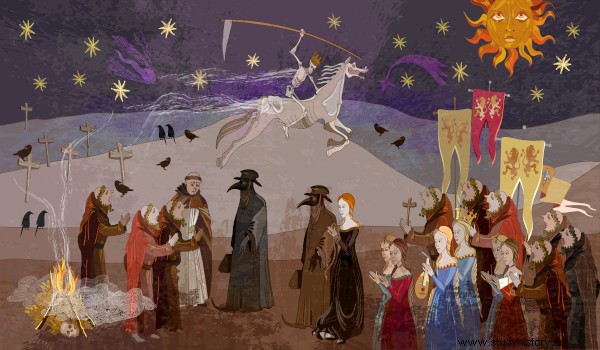A plague black is a disease a caused by the bacillus Yersinia pestis , which triggered a pandemic, that is, a widespread proliferation, which occurred in the second half of the 14th century in Europe, killing a third of the population of that continent. This plague was part of the series of events that contributed to the crisis of the Late Middle Ages, such as the peasant revolts, the Hundred Years War and the decline of medieval chivalry.
Also read: Five diseases that marked the history of humanity
Origin and spread of the Black Death
The Black Death has its origin on the Asian continent , precisely in China. Its arrival in Europe is related to the caravans of trade that came from Asia through the Mediterranean Sea and arrived in European coastal cities, such as Venice and Genoa. It is estimated that about one third of the European population has been decimated by the plague.
The spread of the disease was initiallythrough rats and, mainly, fleas infected with the bacillus, which ended up being transmitted to people when they were bitten by the fleas – in whose digestive system the plague bacteria multiplied. At a more advanced stage, the disease began to spread byairway , through sneezes and droplets.
Contributed to the spread of the disease the poor hygiene and housing conditions that medieval cities and towns had – which provided conditions for rat and flea infestations.
Another phenomenon at the time when the plague broke out was the attribution of the cause of the disease to foreign peoples , especially the Jews. The Jews, for not being from Europe and for, since the Ancient Age, live in constant migration , passing through several regions of the world until they settled in the domains of the European continent, they ended up becoming the “scapegoat” of the angry mobs. Thousands of Jews were killed during the outbreak of the plague.

One of the attempts at understanding of the deadly phenomenon of the Black Death can be seen in the pictorial representations of the so-called “The macabre dance ”, or “The Dance of Death ”. The paintings that portrayed the “dancing macabre” presented a clear conception of the inexorability of death and the putrefaction of the body . In these paintings, human skeletons always appear “dancing” among all kinds of people, from lords and clerics to artisans and peasants – thus evidencing the universal character of death .
See also: Spanish flu – a pandemic that occurred in the 20th century
Symptoms of the Black Death
As there was still no satisfactory development of medical science at this time, the causes of the plague were not known, nor were the means of treating it or cleaning cities and towns. The plague was called “black” because of the skin conditions of the person affected by it, that is, the disease caused large black spots on the skin , followed by swelling in regions of high concentration of lymph nodes, such as the groin and armpits.
These bumps were also known as “buboes ”, so pthis n egra is also known as p this b ubonic . Death from the plague was painful and terrible, as well as rapid, as it varied from two to five days after infection.
